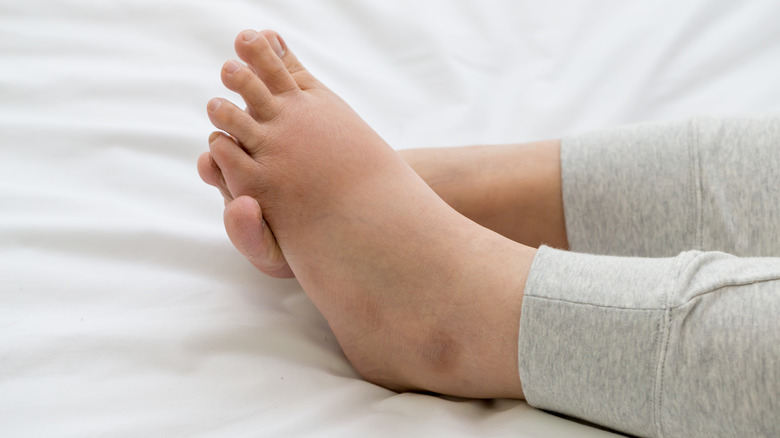Everything You Need To Know About Oedema
Oedema (also known as edema) is the medical term for fluid retention or swelling. It occurs when fluid accumulates in the body's tissues, causing them to swell. Oedema can affect any part of the body, but it is most commonly seen in the legs, ankles, and feet. There are two types of oedema: pitting and non-pitting (via Healthline). Pitting oedema is when pressure on the swollen area leaves an indentation (pit) that takes a few seconds to disappear, while non-pitting oedema does not leave a pit.
There are many different causes of oedema (via NHS). This condition can be the result of kidney or heart problems or liver disease or of a condition called venous insufficiency, which is when the veins are not able to efficiently pump blood back to the heart, leading to a build-up of fluid in the legs. Pregnancy is a common cause of oedema because as the baby grows, it puts pressure on the mother's pelvis and abdomen, which can lead to a build-up of fluid. Some medications, such as steroids and non-steroidal anti-inflammatory drugs (NSAIDs), can also cause fluid retention, as well as sitting or standing for long periods of time and eating a high-sodium diet.
Symptoms and treatment of oedema
The most common symptom of oedema is swelling. This can be accompanied by pain, stiffness, and a feeling of heaviness in the affected area (via Cleveland Clinic). The skin may also feel tight and look shiny. In severe cases, the skin may break down and form ulcers. Other symptoms include shortness of breath and difficulty breathing, depending on where the swelling occurs.
Oedema is diagnosed based on a physical examination and the patient's medical history. Imaging tests, such as X-rays, computed tomography (CT) scans, or magnetic resonance imaging (MRI), may be ordered to rule out other conditions. Blood tests may also be done to check for underlying conditions that could be causing oedema. Oedema can be treated with lifestyle changes, such as diet and exercise, and medications. Diuretics may be prescribed to help reduce the swelling by increasing urine output. Compression stockings may also be recommended to help reduce swelling in the legs. In severe cases, surgery may be necessary to remove excess fluid from the body. With treatment, most people with oedema improve and can lead normal, active lives.


